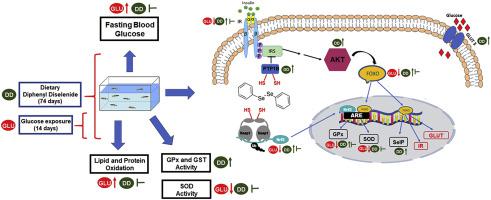Free Radical Biology and Medicine ( IF 7.1 ) Pub Date : 2020-06-13 , DOI: 10.1016/j.freeradbiomed.2020.06.002 Matheus M Dos Santos 1 , Gabriel T de Macedo 1 , Alessandro S Prestes 1 , Assis Ecker 1 , Talise E Müller 1 , Jossiele Leitemperger 1 , Bárbara D Fontana 2 , Daniel M P Ardisson-Araújo 1 , Denis B Rosemberg 3 , Nilda V Barbosa 1

|
The organic selenium compound diphenyl diselenide (DD) has been recognized as an antioxidant and neuroprotective agent, exerting an anti-hyperglycemic effect in experimental models of diabetes. However, the precise mechanisms involved in the protection are unclear. Using the zebrafish (Danio rerio) as a model organism, here we investigated biomarkers underlying the protective effects of DD against hyperglycemia, targeting in a transcriptional approach the redox and insulin-signaling pathway. Fish were fed on a diet containing DD (3 mg/kg) for 74 days. In the last 14 days, they were exposed to a 111 mM glucose solution to induce a hyperglycemic state. DD reduced blood glucose levels as well as normalized the brain mRNA transcription of four insulin receptors-coding genes (Insra1, Insra2, Insrb1, Insrb2), which were down-regulated by glucose. DD alone caused an up-regulation of relative mRNA transcription in both Insra receptors and glucose transporter 3 genes. DD counteracted hyperglycemia-induced lipid peroxidation, protein and thiol depletion. Along with the decreased activity of antioxidant enzymes SOD and GPx, the brain of hyperglycemic fish presented a reduction in mRNA transcription of FoxO3A, FoxO3B, Nrf2, GPx3A, SOD1, and SOD2 genes. Besides normalizing the transcriptional levels, DD caused an up-regulation of relative mRNAs that encode Nrf2, FoxO1A, FOXO3A, GPx4A, PTP1B, AKT and SelP. Collectively, our findings suggest that the antioxidant and anti-hyperglycemic actions of DD in a zebrafish diabetes model are likely associated with the regulation of the oxidative stress resistance and the insulin-signaling pathway and that could be related to the modulation at mRNA level of two important transcription factors, Nrf2 and FoxO.
中文翻译:

氧化还原和胰岛素信号传导的调节是斑马鱼中二苯二硒化物的抗高血糖和抗氧化作用的基础。
有机硒化合物二苯二硒化物(DD)已被认为是抗氧化剂和神经保护剂,在糖尿病的实验模型中具有抗高血糖的作用。但是,保护的确切机制尚不清楚。使用斑马鱼(Danio rerio)作为模型生物,在这里我们研究了DD对高血糖的保护作用的潜在生物标志物,其目标是转录方式的氧化还原和胰岛素信号通路。以含DD(3 mg / kg)的饮食喂鱼74天。在最后的14天中,将他们暴露于111 mM葡萄糖溶液中以诱发高血糖状态。DD降低了血糖水平,并使四个胰岛素受体编码基因的脑mRNA转录正常化(Insra1,Insra2,Insrb1,Insrb2),它们被葡萄糖下调。DD单独导致Insra受体和葡萄糖转运蛋白3基因的相对mRNA转录上调。DD抵消了高血糖引起的脂质过氧化,蛋白质和巯基消耗。随着抗氧化酶SOD和GPx活性的降低,高血糖鱼类的大脑呈现出FoxO3A,FoxO3B,Nrf2,GPx3A,SOD1和SOD2基因的mRNA转录减少。DD除了使转录水平正常化外,还引起编码Nrf2,FoxO1A,FOXO3A,GPx4A,PTP1B,AKT的相对mRNA的上调和SelP。总的来说,我们的研究结果表明,斑马鱼糖尿病模型中DD的抗氧化和降血糖作用可能与抗氧化应激和胰岛素信号通路的调节有关,并且可能与两种mRNA水平的调节有关。重要的转录因子Nrf2和FoxO。











































 京公网安备 11010802027423号
京公网安备 11010802027423号